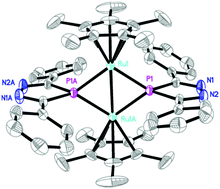A dipotassium 1,2,4-diazaphospholide dianion radical as an organometallic building block: the first 1,2-diaza-4-phosphine ruthenocene†
Abstract
A persistent dipotassium 3,5-diphenyl-1,2,4-diazaphospholide dianion radical {K+2[(3,5-Ph2dp)]˙2–} (2) was synthesized and investigated by EPR analysis and magnetic susceptibility measurement, and it can be used as a transfer agent for the preparation of an unusual 1,2-diaza-4-phosphine ruthenocene (4) with exclusive σ(P)-coordination. A plausible mechanism for the formation of 4 was proposed as one that involves a reactive radical intermediate {K+[(η5-CpMe5Ru)(σ(P),σ(C)-(3,5-Ph2dp)˙]−)} (K+[5A˙]−) with σ(P)-coordination due to the high spin density (SD) at the phosphorus (σ2λ3) atom.



 Please wait while we load your content...
Please wait while we load your content...